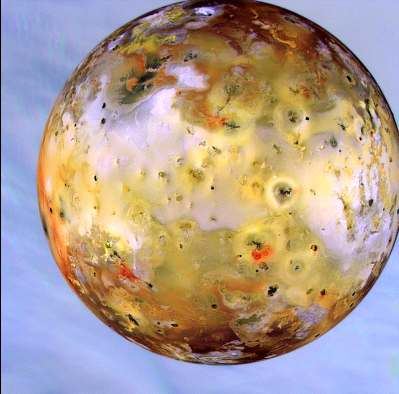|
----------------- a work of fiction Jupiter moons ----------------- to Galileo |
|
|
|
|
|
||
|
----------------- a work of fiction Jupiter moons ----------------- to Galileo |
|
The modern chapter of Io research began in 1955, when a radio-astronomy experiment Ken Franklin and Bernie Burke discovered a strange celestial radio source which kept shifting its position. It turned out to be Jupiter, and later observations on the Earth's own magnetosphere suggested the signals came from a dense population of trapped particles. Those emissions however were not completely random--in part they required a specific position of Io relative to the Jupiter-Earth line.
 Pioneer 10 and 11 observed Jupiter's radiation belt, but the high radiation intensity frustrated detailed observations of Io. Voyager 1 passed close to Io on March 5, 1979 and found it to be the most active volcanic body in the solar system. That happened just a few weeks after an article in "Science" (by Peale, Cassen and Reynolds) predicted Io's interior to be heated by alternate squeezing due to the gravity of Europa and Ganymede.
Pioneer 10 and 11 observed Jupiter's radiation belt, but the high radiation intensity frustrated detailed observations of Io. Voyager 1 passed close to Io on March 5, 1979 and found it to be the most active volcanic body in the solar system. That happened just a few weeks after an article in "Science" (by Peale, Cassen and Reynolds) predicted Io's interior to be heated by alternate squeezing due to the gravity of Europa and Ganymede.
To the Voyager 1 camera Io presented a strange surface of colored volcanic deposits (like the image shown here, taken by "Galileo" on 7 September 1996). Then one of the engineers, Linda Morabito, looked at the edge of the planet and discovered a huge glowing fountain rising above it. Later other active, glowing volcanic vents were also located. Io's volcanoes may be the source of many of the ions in Jupiter's magnetosphere, and they also account for the "Io torus," a ring of glowing sodium atoms tracing Io's orbit. They also seem to be the source of Io's ionosphere, though the satellite itself may also be a fair conductor of electricity. Either or both of these make possible an electric circuit, linking Io and Jupiter's ionosphere, with Jupiter's magnetic field lines creating a conducting link, since electric conductivity in a plasma proceeds easily along such lines. In a circuit of this sort, where one conductor moves relative to the other in a way which (at least in part) cuts across magnetic field lines, a dynamo effect is created, using energy of the relative motion to generate an electric current. The Io dynamo is an example of this, too, though here the main cause of the motion is not the orbital motion of Io--rather, it is the rotation of plasma trapped in Jupiter's magnetic field, forced by electromagnetic forces ("freezing of field lines to the plasma") to keep step with the fast rotation of the planet. Voyager 2, passing Io on July 9, 1997, was steered to cross those field lines, and detected the magnetic disturbance of its currents, which also seem to be the cause of the modulated radio emission. Where the currents intersect the ionosphere of Jupiter, an intense polar aurora is created--a process somewhat similar to the one responsible for aurora near Earth. The fact that multiple auroral bands have been observed suggests that magbe other moons of Jupiter also generate dynamo action. As noted earlier, to date 63 satellites of Jupiter have been tallied. The other big ones, Io, Europa, Ganymede and Callisto, are icy and have strange markings, including "palimpsest craters," ring-like structures due to impacts which probably once created crater walls like those on our own Moon, but which sagged to the surface, leaving only an outline marking, because ice tends to flow under gravity (as it does in glaciers on Earth). Some researchers have found indications of a briny ocean beneath Europa's frozen surface, but the likelihood of it harboring life seems small |
Next Planet: #P-9 Saturn
Next Stop (following "The Planets"): #9c The Discovery of the Solar System, from Copernicus to Galileo
Timeline Glossary Back to the Master List
Author and Curator: Dr. David P. Stern
Mail to Dr.Stern: stargaze("at" symbol)phy6.org .
Last updated: 18 February 2008